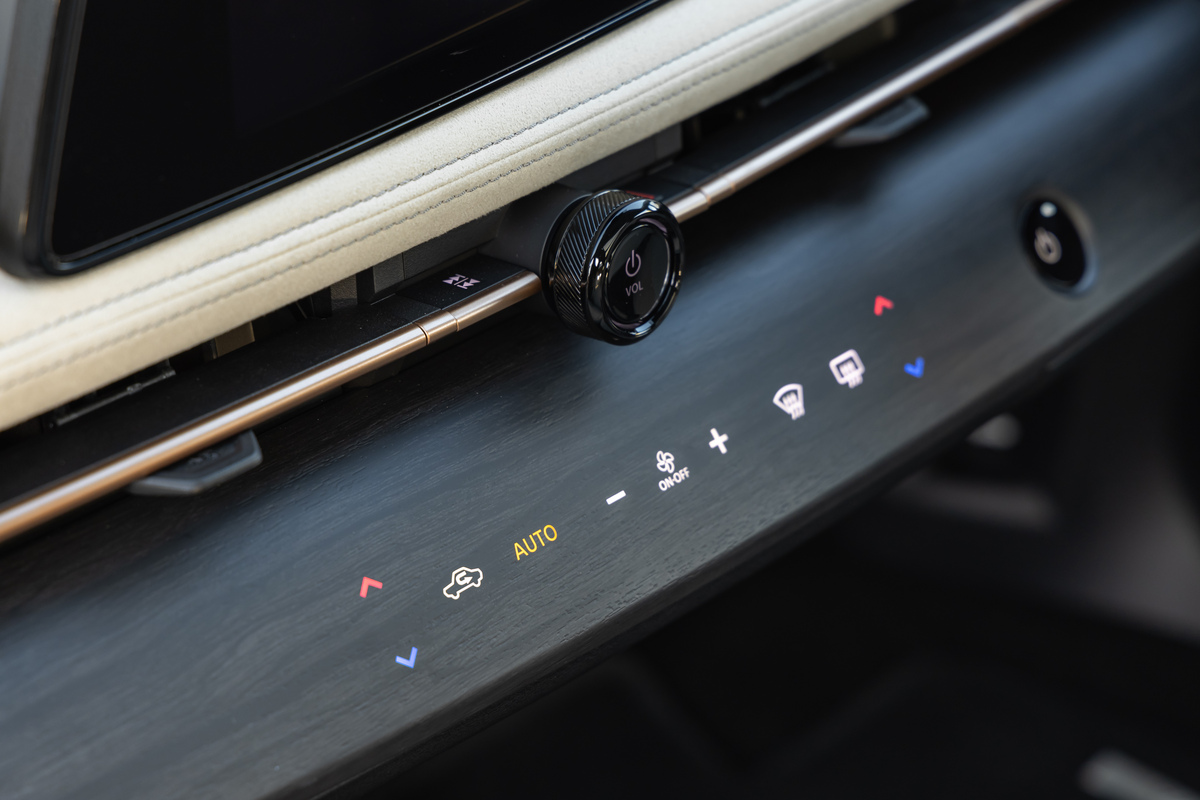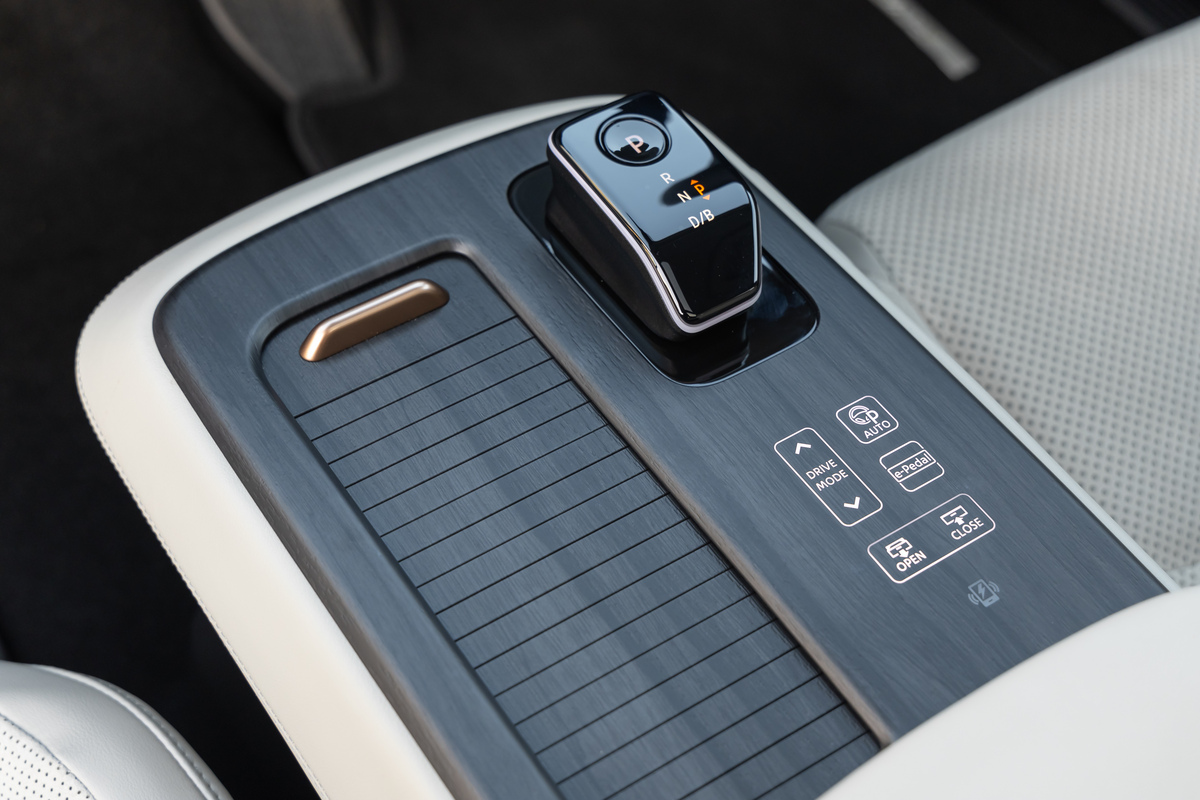
The Nissan Ariya enters a crowded field of midsized electric crossovers, and on paper, it doesn’t promise anything especially radical. Efficiency is average, the charging speeds are merely competitive and the opinions on exterior design are divided. Yet step inside and the car’s priorities become clear. This review continues our series exploring in-car technology and materials.
Minimalist cabin design
The Ariya’s cabin does not reinvent the electric vehicle interior, but it does apply its chosen theme with unusual consistency. It is clean rather than clinical, using broad surfaces and a simple architecture that emphasizes width and space. Nissan leans into Japanese design cues, and while some of the branding language may come across as lofty, the execution is careful: subtle lighting along the footwells, patterned finishes that echo traditional woodworking and a “floating” dashboard that avoids visual clutter.
The overall effect is soothing. This cabin is not chasing hyper-modern theatrics; instead, it aims to feel organized, warm and calm. It largely succeeds.

[Source: Nissan]
Materials and finish
Material quality is strong for a mainstream EV — arguably one of the Ariya’s differentiators. Soft-touch finishes cover much of the upper cabin, and even the entry-level Engage trim offers a coherent aesthetic rather than the stripped-back feel some base models exhibit. The grey fabric upholstery in the Engage is simple but well executed and suits the minimalist approach, although it lacks the richer surfaces of mid- and high-spec variants.
Lower down, harder plastics start to appear, and this is the point where rivals such as the Hyundai Ioniq 5 or Volvo EC40 advance. Still, the Ariya offers enough tactility and attention to detail to feel more premium than the badge alone suggests.
One caveat is that the illuminated haptic controls embedded in the dashboard wood-effect trim look distinctive but require deliberate pressure and can be awkward to use. They prioritize styling over ease of interaction.

[Source: Nissan]
Layout and space
An advantage of the Ariya’s platform is its packaging efficiency; the low, relatively slim battery allows for a true flat floor and a naturally spacious cabin. Consequently, the front occupants get generous leg and shoulder room, a relaxed driving position and excellent forward visibility thanks to the low-set dashboard, while rear passengers benefit from strong legroom, unrestricted foot space and a seating posture that avoids the “knees-up” issue common in EVs with thicker battery packs. Headroom is generally good, although the optional panoramic roof reduces it slightly. The Ariya manages to feel wide, airy and well-proportioned without seeming bulky, and that impression holds even in the Engage trim, which forgoes luxuries like the panoramic roof and power seats but retains the platform’s core spatial advantages.
Storage and practicality
The Ariya offers a handful of genuinely useful interior storage solutions. The large center console box, deep door pockets, and a well-designed glove box provide everyday practicality. In most trims, the standout feature is a powered sliding center console that can move fore and aft. It allows users to tailor the front cabin layout or create a temporary workspace — a rare feature in this class.
However, the Engage trim swaps this powered module for a fixed unit, losing the novelty and adaptability. Likewise, the central dashboard drawer, which is large and motorized in higher trims, becomes a smaller manually operated panel in the Engage. It still adds some visual interest, but its usefulness is limited.
The overall storage offering is therefore competent in the Engage and genuinely clever in the more expensive versions.

[Source: Nissan]
Infotainment and controls
The Ariya’s twin 12.3-inch displays for the instrument cluster and infotainment look modern and well-integrated, but as interfaces they’re functional rather than competitive at the sharp end of the class. The graphics feel dated and lack crisp contrast, responses are generally adequate but can hesitate, and the reversing camera quality trails newer rivals. Much of the climate and shortcut functionality sits on haptic panels that look elegant in the cabin yet prove less intuitive to use on the move. With wireless Apple CarPlay and wired Android Auto available, many drivers will understandably default to phone mirroring to bypass Nissan’s own software. The system is perfectly usable, but it’s one of the areas where the Ariya most clearly shows its age.

[Source: Nissan]
Seating and comfort
Comfort is one of the Ariya’s strongest qualities. The seats, though simpler in the Engage trim, are well-shaped and softly padded, offering long-journey comfort. More expensive trims add cooling, heating and memory functions, but the Engage’s basic chairs still perform well.
What really sets the Ariya apart is its refinement. The cabin remains impressively quiet across a range of speeds thanks to effective insulation, aerodynamics and tyres designed to reduce noise on varied surfaces. Wind and motor noise are minimal, allowing the interior to feel almost cocoon-like.
This refinement reinforces the Ariya’s persona: more “smooth mobility pod” than driver’s car, but undeniably pleasant for everyday journeys.
Rear accommodation and trunk space
The rear cabin continues the front cabin’s theme of comfort and space. Knee and foot room are strong, and the seating feels naturally supportive. Three adults can fit for shorter trips, though the center seat is predictably firmer and higher.
The trunk, however, is less impressive. At 466 liters in front-wheel-drive models and less in dual-motor variants, capacity trails that of several key competitors. The flexible double-floor with partitions is clever and adds useful organization options, but overall volume remains average for the class. The absence of a front boot further limits cable storage.
Equipment levels
One of the Ariya’s clear advantages is its generous standard equipment: even the entry-level Engage trim comes with LED lighting, a full suite of safety and driver-assist systems, twin large displays, wireless CarPlay, and a heat pump — a genuinely useful inclusion for maintaining efficiency in colder weather. However, buyers seeking added convenience, such as a power tailgate, power seats, a panoramic roof, a 360-degree camera or a sliding center console, will need to climb the trim ladder. The Engage is not stripped bare, yet it is not especially aspirational either; it serves as a functional, well-equipped entry point that preserves the Ariya’s core strengths while omitting many of the touches that make the higher trims feel special.
In an increasingly crowded electric SUV market, the Nissan Ariya’s interior stands out less for novelty than for its consistency, refinement and design clarity. It may not break new ground, and some of the technology already feels a step behind, but the fundamentals are strong: a cohesive, calming design; solid perceived quality; impressive refinement and near-silent cruising; a spacious cabin with thoughtful storage touches; and generous standard equipment across the range. Its weaknesses are equally clear — dated infotainment graphics and cameras, haptic controls that frustrate more than they help, a merely average trunk and some desirable features pushed to higher trims. Still, for buyers who value minimalist interiors, a sense of serenity and an overall pleasant place to spend time, the Ariya delivers one of the more soothing cabins in the class — arguably its most compelling asset.
S&P Global Mobility’s latest report on “New interiors: Function integration, materials and new concepts” offers a detailed analysis of how automakers are pursuing the twin goals of integrating smart functions into interior trim components and increasing the use of sustainable materials.








